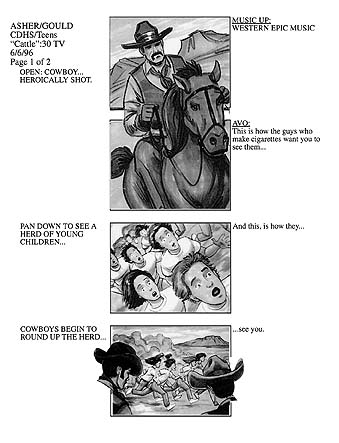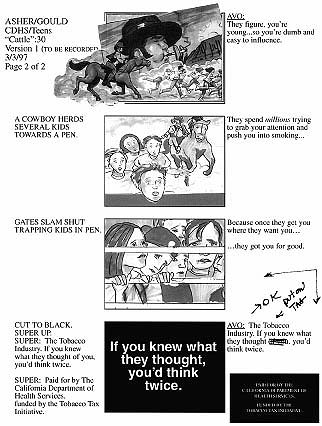The Strengthened Advertisements
In February 1997 the administration responded to pressure about the advertisements by again revising the televised advertisements, although this fact was not made public at the time. On February 28, 1997, Lynda

Figure 26a. “Cattle” as finally produced. In response to strong pressure from public health advocates, the words “tobacco industry” were added into the voiceover at the end of the advertisement.

Figure 26b.
By the time Asher/Gould prepared the final storyboards on March 3, 1997, two versions of “Voicebox” were planned. In addition to the cessation advertisement, a version was recreated that emphasized addiction and the behavior of the tobacco industry. In it, the actor says, “They say nicotine is not addictive. How can they say that?”; the tag line at the end was “The tobacco industry denies that nicotine is addictive.”
At the TEROC meeting on March 25, John Pierce, director of the California Tobacco Survey, presented the latest California smoking prevalence data, which showed that smoking rates for both youth and adults appeared to be going up. Overall, youth smoking, which had been as low as 8.7 percent in 1992, rose to 11.9 percent in 1995 and remained flat in 1996 at 11.6 percent. The annual Behavioral Risk Factors Survey conducted in house at DHS showed that adult smoking prevalence had increased from 16.7 percent to 18.6 percent between 1995 and 1996,[61] reversing a downward trend that had existed for nearly a decade.[24][62] The increase in smoking rates received wide media coverage.[62-64] Public health groups blamed the increase on the fact that the administration had not fully funded Proposition 99's anti-tobacco education programs and on its reluctance to attack the tobacco industry. Sean Walsh, the governor's press secretary, commented that he was frustrated because Wilson was being blamed for everything—“including [the comet] Hale-Bopp.”[62] He referred to the public health groups' criticisms as “Chicken Little-like comments made by zealots in the anti-smoking community.”[64]
TEROC finally saw the new advertisements at its March 25 meeting, after they were released to the public, and Cook indicated that the members' reactions were mixed.[37] The advertisements as released, nine months after Asher/Gould originally proposed them, were similar to those originally conceived by the advertising agency.
While the health groups did manage to get the 1997 advertisements strengthened, the administration's reluctance to go after the tobacco industry remained. On February 10, 1998, Christine Steele of Asher & Partners (the new name for Asher/Gould) was once again having to justify to Genest the strategy of countering tobacco industry influence, commenting that “this approach is important, relevant and, without question, necessary.”[65]